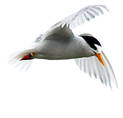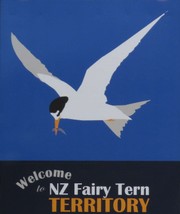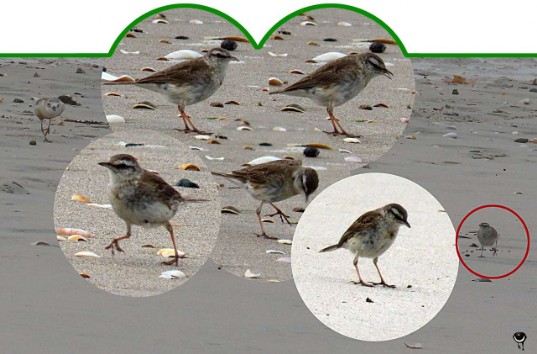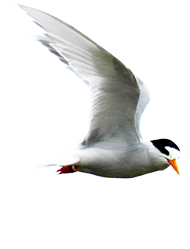Etappen Nordinsel

 Waipu Cove
Waipu Cove 
11. - 14. December – Waipu Cove
 Fairy tern – Die letzten Vierzig – The Last Forty
Fairy tern – Die letzten Vierzig – The Last Forty
(damaging) . So from the road we emailed the Department of Conservation in Whangarei.
We received a friendly reply and several locations where we could observe the Fairy Terns with luck. This included the mouth of the Waipu River, a nature reserve where we would be lucky to see them fishing. So at some point we turned off the A1 towards Mangawhai Harbour, from there we drove in pouring rain on a winding and scenic route to WaIpu Cove. Here we checked in at the friendly campground. The next day it had cleared up and after breakfast we drove a few kilometers further to the nature reserve. Open result. It was just before high tide, so quite a few birds were cavorting on the sandbanks. We walked slowly through the shallows, stopping again and again. Looked through binoculars. There were many Godwits. And among the Godwits - a Small Wonder, a Great Astonishment: a petite tern with an orange bill and black eye rings was sitting among the Godwits, preening itself profusely. That was the Fairy Tern!!!




 Behind Auckland, a well-developed highway section began for which we could pay our toll electronically. This system of refinancing is currently being used to finance three new road projects on the North Island.
Behind Auckland, a well-developed highway section began for which we could pay our toll electronically. This system of refinancing is currently being used to finance three new road projects on the North Island.Shortly after the end of the upgraded section, the skies closed in again. It poured with rain, and damp mist hung over the forested hilltops in the warmth. The next day, the first in Waipu Cove, it had cleared up. The photos show the nature reserve at the mouth of the Waipu River. We visited the area four times during our time, each time was different, the dynamics between water and land always produced new impressions, and again and again the Fairy Tern was there.

↑ Kōtare – Todiramphus sanctus – Götzenliest – Sacred kingfisher
Native – Einheimisch


↑ Tara iti – Sternula nereis davisae– Australseeschwalbe – Fairy tern
Sternula nereis davisae: Endemic - Endemisch NZ
 The little tern with light gray upper side and white underside, white rump, white forked tail belongs to the Little Terns - genus Sternula. Breeding adult birds have a completely yellow-orange bill and a black cap extending from the crown to the nape. The black spot in front of the eye is also distinctive, but it never reaches the bill. These black spots give the Fairy Tern something fancy. She is also affectionately called Tara Iti (Mauri name) in New Zealand.
The little tern with light gray upper side and white underside, white rump, white forked tail belongs to the Little Terns - genus Sternula. Breeding adult birds have a completely yellow-orange bill and a black cap extending from the crown to the nape. The black spot in front of the eye is also distinctive, but it never reaches the bill. These black spots give the Fairy Tern something fancy. She is also affectionately called Tara Iti (Mauri name) in New Zealand.
Tara Itis nest on only five beaches in northern Auckland in shell-covered sand, usually above the spring high tide mark. Eggs are sand-colored with tiny dark spots, weigh 12-13 grams, and are 25 mm x 35 mm. Both partners incubate the eggs during the incubation period of about 23 days. Already after three weeks the chicks are fledged.
Tara Itis are the most endangered endemic bird species in New Zealand. A remnant population of less than a dozen pairs survives between Whangarei in the north and Auckland in the south. This tiny population is severely threatened by introduced predators and human disturbance or encroachment. Predators: rats, dogs, cats, hedgehogs, weasels, ferrets and stoats prey on eggs, chicks and adult birds. Environmental events such as floods, storms and strong winds destroy nests, kill chicks. Strong winds and persistent rain affect terns in their search for food and in raising their young.

There are therefore comprehensive protection and conservation measures for the charming little terns: they are intensively cared for by the Department of Conservation and the New Zealand Fairy Tern Charitable Trust, especially during the breeding season. In this context, eggs are also repeatedly rescued and hatched at Auckland Zoo to strengthen the population and compensate for losses in the wild. The chicks hatched in Auckland are trained in a special enclosure for release into the wild, learn to catch live fish , to be self-sufficient in perspective. This group of fledglings will be particularly important to the survival of the population this season, as chicks did not survive Cyclone Gabrielle at Waipu Cove, for example.
(New Zealand Fairy Tern Charitable Trust Annual Report, March 2023 Newsletter).

 Fairy Terns on the wall of the sanitary building of our campsite.
Fairy Terns on the wall of the sanitary building of our campsite.
↑ Kuaka – Limosa lapponica – Pfuhlschnepfe – Bar-tailed godwit
Native – Einheimisch

↑ Tūturiwhatu – Charadrius obscurus aquilonius – Nördlicher Maoriregenpfeifer – northern New Zealand dotterel
Endemic - Endemisch NZ
 The New Zealand Dotterel also lived in the nature reserve.
The New Zealand Dotterel also lived in the nature reserve.
↑ Tōrea pango – Haematopus unicolor – Neuseeländischer Austernfischer – Variable oystercatcher
Endemic - Endemisch NZ

↑ Vanellus miles novaehollandiae – Maskenkiebitz – Spurwinged Plover
Native – Einheimisch

↑ Tākapu – Morus serrator – Australischer Tölpel –Australasian gannet
Native – Einheimisch

↑ Taranui – Hydroprogne caspia – Raubseeschwalbe – Caspian tern
Native – Einheimisch

↑ Kawaupaka – Microcarbo melanoleucos – Australische Kleinscharbe – Little shag
Native – Einheimisch

↑ Tara – Sterna striata – Taraseeschwalbe – White fronted tern
Native – Einheimisch

↑ Pīhoihoi – Anthus novaeseelandiae – Neuseeland-Spornpieper – New Zealand pipit
Endemic – Endemisch NZ

↑ Tūturiwhatu – Charadrius obscurus aquilonius – Nördlicher Maoriregenpfeifer – northern New Zealand dotterel
Endemic - Endemisch NZ

↑ Pukeko – Porphyrio melanotus –Purpurhuhn – Pukeko
Native – Einheimisch

 On flip flops, the lukewarm shallow water of the Estuary was easier to cross, let's say relatively easier. Because the muddy ground let the flip flops get stuck once or twice. But then they could be rinsed off again simply under water.
On flip flops, the lukewarm shallow water of the Estuary was easier to cross, let's say relatively easier. Because the muddy ground let the flip flops get stuck once or twice. But then they could be rinsed off again simply under water.
↑ Kāruhiruhi – Phalacrocorax varius – Elsterscharbe – Pied shag
Native – Einheimisch

↑ Tara iti – Sternula nereis davisae– Australseeschwalbe – Fairy tern
Sternula nereis davisae: Endemic - Endemisch NZ
 On another visit to the Waipu River estuary in the evening, the Fairy Tern was there again. Tirelessly in the air looking down into the water, then swooping down, 70 grams of energy with an appetite for fish.
On another visit to the Waipu River estuary in the evening, the Fairy Tern was there again. Tirelessly in the air looking down into the water, then swooping down, 70 grams of energy with an appetite for fish.








 In Mangawhai, we parked at the Mangawhai Museum, walked along Molesworth Drive, then turned onto a small path below the settlements, which was quickly under water due to the high tide and rain. We then continued walking on a newly constructed footbridge through the mangroves.
In Mangawhai, we parked at the Mangawhai Museum, walked along Molesworth Drive, then turned onto a small path below the settlements, which was quickly under water due to the high tide and rain. We then continued walking on a newly constructed footbridge through the mangroves.
↑ Matuku moana – Egretta novaehollandiae – Weißwangenreiher – White-faced heron
Native – Einheimisch

↑ Maina – Acridotheres tristis – Hirtenmaina – common myna
Asian introduced – eingeführt und eingebürgert.

↑ Avicennia marina australlasica – Graue Mangrove – grey mangrove
Native – Einheimisch

 The footbridge through the mangroves had only recently been built by volunteers - a demanding job - and opened up views into the mangrove ecosystem with its inhabitants.
The footbridge through the mangroves had only recently been built by volunteers - a demanding job - and opened up views into the mangrove ecosystem with its inhabitants.Little princess
Suddenly excitement came into the little body. And then another Fairy Tern with little fish in her beak landed next to her. The fish was handed over. Then the other bird flew off again. We followed his flight with binoculars. Again and again he stood in the air, shook his wings, swooped down, flew up again. He tried to catch it again. Then he had success. It continued to rain, but we forgot about rain and time. The female Fairy Tern continued to sit in her position. Looked around, watched him catch fish. Then she emitted a few pointed cries as the partner - again with fish - approached, landed and handed it to her. We were just allowed to observe the ritual by which tern pairs affirm their allegiance to each other at the beginning of the breeding season. And in addition evidence in patience of waiting and perseverance in fishing.

↑ Tara iti – Sternula nereis davisae– Australseeschwalbe – Fairy tern
Sternula nereis davisae: Endemic - Endemisch NZ
 In summary: In total we were in Waipu Cove from Sunday evening to Thursday morning. We visited the sanctuary several times, were in Mangawhai more often, also for shopping. Quite a few Flat Whites decaf were enjoyed at the Cafe' in Waipu Cove overlooking the ocean. Also a special Japanese breakfast omelet on the day of departure. We were swimming in the ocean and wading through rain puddles at the campground. We passed Langs Beach, where the waves broke foamy on the rocks, several times and soon knew every bend and tree on the stretch between Mangawhai and Waipu Cove.
In summary: In total we were in Waipu Cove from Sunday evening to Thursday morning. We visited the sanctuary several times, were in Mangawhai more often, also for shopping. Quite a few Flat Whites decaf were enjoyed at the Cafe' in Waipu Cove overlooking the ocean. Also a special Japanese breakfast omelet on the day of departure. We were swimming in the ocean and wading through rain puddles at the campground. We passed Langs Beach, where the waves broke foamy on the rocks, several times and soon knew every bend and tree on the stretch between Mangawhai and Waipu Cove.The Fairy Terns brought us here to this beautiful area and helped us to the highlight of our entire trip, they were the highlight.








